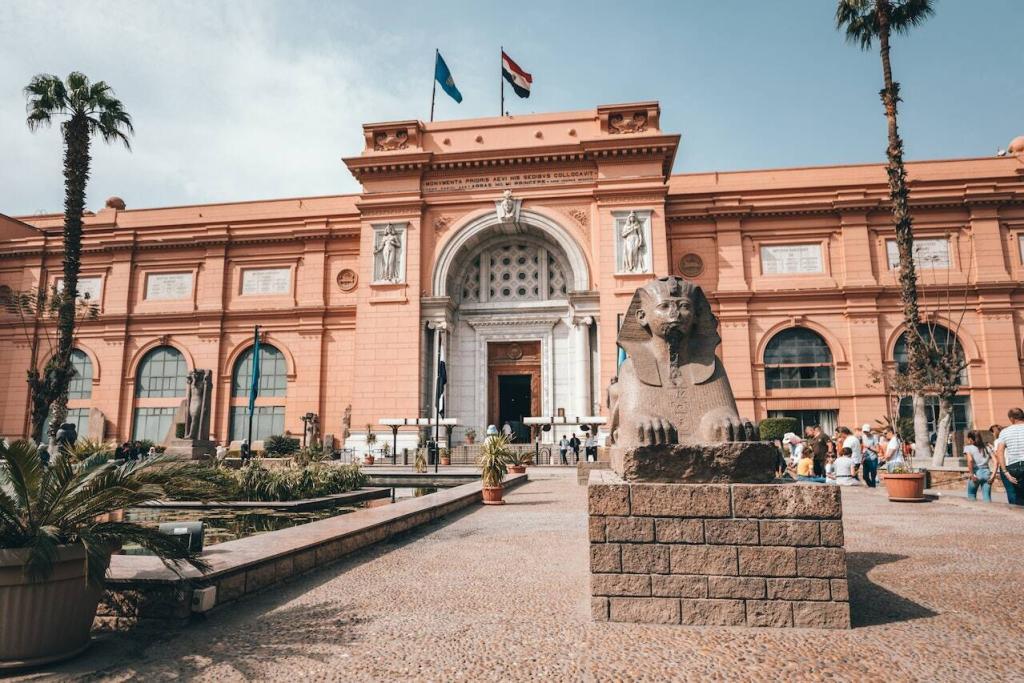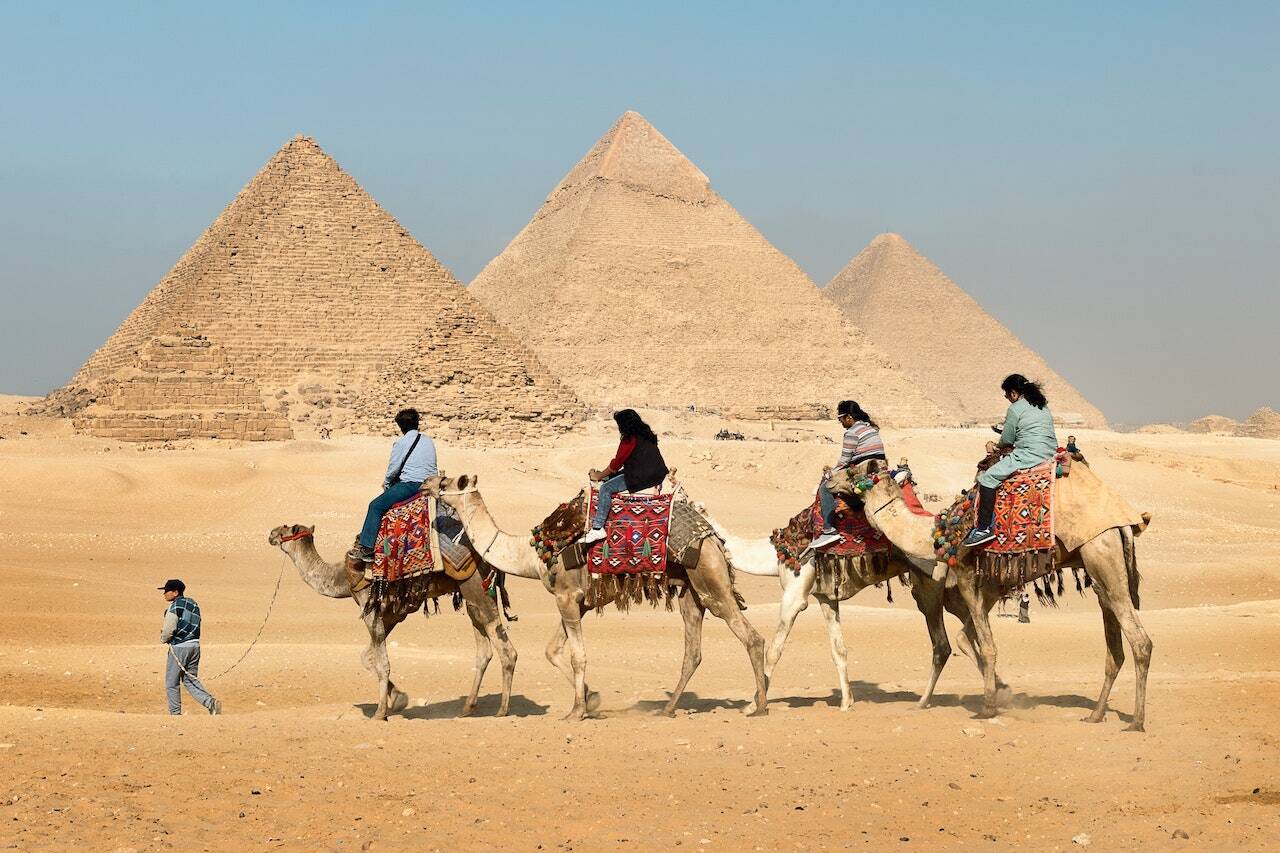Ever dreamt of swapping your morning coffee for a cup of Nile-side tranquility? Or trading in your daily commute for a camel ride amidst the pyramids? Say no more! Dive into our “Egypt Itinerary 7 Days” guide that’s hotter than a Sahara afternoon. We’re not just talking about the usual pyramid pit stops. Oh no, this is the ultimate week-long whirlwind through Egypt’s wonders, where mummies still whisper and Cleopatra’s legacy lingers. So, dust off your adventure hat and let’s turn those hieroglyphic dreams into a reality! 🐫🌞🏺
Day 1
Egyptian Museum (Morning)
The Egyptian Museum is located in Tahrir Square at the heart of Cairo. Visit this museum to witness the golden mask of the Egyptian Pharaoh and the many mummies representing different pharaohs and Egyptian royals. Other exhibits in the museum include obelisks, sphinxes, and stone carvings. Besides, there is so much to learn in the Egyptian Museum that you are best off with a local tour guide.

Cairo Citadel (Afternoon)
The Cairo Citadel, also known as the Saladin Citadel, is a castle built by General Saladin in the 11th century. The General built this majestic castle to defend the city against invasion. The city wall stands at 2 meters, and the castle consists of the inner and outer cities. Several relics of all dynasties are at this location, including the National Military Museum, the Youssef well, and the ancient canal. Further, you can visit each site individually based on the time you have at hand.
Day 2
Cairo Tower (Morning of your egypt itinerary 7 days)
Cairo Tower represents the shape of Egypt’s national flower, the lotus. It is located on Zamalek Island in the Nile River. A climb up the tower will provide panoramic views of Cairo city, which is best viewed at night. This 187-meter-high concrete tower is the tallest building in North Africa. The late Egyptian President Nasser laid the foundation stone for this 60-storey building. Moreover, the tower is popular for finding directions when traveling in Cairo. In addition, the Pyramids of Giza are towards the southwest of the tower, which has a revolving restaurant.
Mit Rahina Museum (Afternoon)
Mit Rahina Museum is an open-air museum which is the only remaining evidence of Memphis, the ancient capital of Egypt. It is located 32 km south of Cairo and has become a ruin. This small museum contains only a lying statue of Ramses II. The original statue was 14 m high and carved from a single limestone block. Due to an earthquake, the statue is now on the museum floor, with its legs and left hand broken.
Day 3
Mosque of Muhammed Ali (Morning)
Located in the Saladin Citadel of the old city of Cairo is the largest mosque in Egypt, the Mosque of Muhammed Ali. The mosque adapts Egyptian and Turkish architectural designs, differentiating it from other mosques in Egypt. The main worship hall takes a square shape with a towering dome. Furthermore, in the mosque’s inner courtyard is the graveyard of the governor of Egypt during the Ottoman Empire. Also, standing in front of the mosque square provides a great view of Cairo city. On a day when the weather is clear, you can also glimpse the pyramids on the other side of the Nile River.
Visit Pyramid of Menkaure (Afternoon)
The Pyramid of Menkaure is the smallest of the three major pyramids in Giza. It is the tomb of the Fourth Dynasty of Egypt, Pharaoh Menkaure. The tomb is on the edge of the Pyramid of Khafre with a smaller entrance. Besides, it is a unique small tomb with a vaulted ceiling. It was originally meant to be made with red granite but was soon changed to limestone halfway through construction.

Day 4
Solar Boat Museum (Morning )
You can find the Solar Ship Museum towards the south side of the Pyramid of Khufu. It exhibits a large wooden ship belonging to Pharaoh Khufu and is the most spectacular ancient ship uncovered in the world to date. A constant temperature system and an anti-corrosion mechanism protect the museum. The museum’s first floor consists of a small model of a solar boat that gives you an understanding of the complete structure of the boat. It is a large boat that is 43.5 m long, 7 m high at the stern, and 5 m high at the bow. Further, an amazing fact about the boat is that it has no nails and consists only of wood and ropes.
Museum of Modern Egyptian Art (Afternoon)
The Museum of Modern Egyptian Art is another great highlight in Cairo during your Day 4 of Egypt Itinerary 7 Days. It is located in the Gezira Exhibition Grounds, opposite the Opera House. The museum mainly consists of work belonging to Egyptian artists and the modern art exhibition of the 20th century. It is a great place to identify how modern Egyptian art differs from ancient Egyptian art. Around 1 hour is enough to peruse the entire museum.
Museum of Islamic Art (Afternoon)
The Museum of Islamic Art is another one of the best museums in Egypt. It contains a valuable collection of artworks from the Islamic world. The artworks themselves are housed in a building based on Islamic architectural elements. Further, there are about 5000 exhibits on display at the Museum of Islamic Art, including rare woodwork and plaster artifacts. Also, there are rare manuscripts of the Holy Book of Islam, the Quran, with calligraphy in silver ink.
Day 5
Nilometer (Morning of your egypt itinerary 7 days)
The Nile River plays a significant role in Egypt. It is the essence of the country and is what it is most renowned for, along with the pyramids. However, since ancient times, this river has flooded annually and disrupted many lives in the surrounding areas. Therefore, to reduce the impact of this flood on people’s lives and the agricultural sector, a measuring instrument named Nilometer was built in 1861. The ancient Egyptians placed large instruments at the river’s bank to measure the water’s rise and fall. Today, the Nilometer stands as a stone pillar where you can climb down spiral stone steps and experience how much the water level would have risen in ancient times. The further you go down this, the gloomier the atmosphere is.
Red Pyramid (Afternoon of your Egypt tour)
The Red Pyramid is located in Dehsur, towards the north of the Bending Pyramid. The pyramid is aptly named so because it contains red limestone with a faint red tint. The Red Pyramid is well-preserved, with fragments of human remains inside it. Further, these remains belong to Pharaoh Sneferu. Moreover, entrance to the inner burial chamber is free, but you need to be careful as the steps are steep.
Day 6
Mosque Madrasa of Sultan Hassan (Morning of your 7 days Egypt itinerary)
The Sultan Hassan Mosque, built in the 14th century, follows the architectural style of the Egyptian Mamluk era. The mosque contains two minarets, out of which the south stands at 86 m. Moreover, the Rifai Mosque is next to this mosque, built 600 years ago. You can enter both mosques through a signal gate and turn left to go to the Sultan Hassan Mosque or right to the Rifai Mosque. The Sultan Hassan Mosque has an inner courtyard and a large pool for showering in the pavilion. In addition, it has four lecture halls with intricate carvings and elegant glass chandeliers hanging from the dome.
The Coptic Museum (Afternoon)
The Coptic Museum is a museum that contains a complete collection of Coptic artworks. It is located in the old Cairo area and combines styles from ancient Greece, Rome, Turkey, Byzantine, and Egypt. The museum consists of two storeys and is built on the ruins of the ancient city of Babylon. Further, it has 25 exhibition halls with displays of manuscripts, stone carvings, textiles, paintings, murals, pottery, and sacred texts that belong to the period between the 4th century and 18th centuries. The exhibits also contain linen clothing from the Egyptians in the 6th and 7th centuries. In addition, this clothing contains a cross-shaped Coptic symbol.
Day 7
Saqqara Pyramids (Morning)
The Saqqara Pyramids are located approximately 30 km south of Cairo city. It is a large cemetery that belongs to the very early period of ancient Egyptian civilization. The place mostly consists of ruins of pyramids and temples of ancient times, almost all of which are badly damaged now. The best preserved is the Step Pyramid, which belongs to the 27th century. Besides, it is the prototype of the pyramids in Egypt today.
Bent Pyramid (Afternoon)
The Bent Pyramid is another must-visit spot, especially when visiting the Saqqara Pyramids. It is a curved pyramid, one of the country’s only remaining smooth-surfaced pyramids. The pyramid’s curved body is unique, with its lower part inclined at 52 degrees and the upper part at 43 degrees. Pharaoh Sneferu, the Fourth Dynasty of Egypt, built this pyramid in 2600 BC. Its curved appearance is kept intact, with two unopened tombs that are not open for public viewing. To the south of the Bent Pyramid is a small subsidiary pyramid. Further to the east is a small mausoleum temple with the ruins of the Sneferu Valley Temple in view along the way.
Finally, Cairo is an amazing city blending ancient and modern times. It’s a place of historical value that you must show your kids.
Lastly, let us know in the comments below what you think of Cairo and its many attractions. Do mention any attraction not in the list above. Also, remember to subscribe to our newsletter for more travel itineraries and top-visit attractions worldwide.

